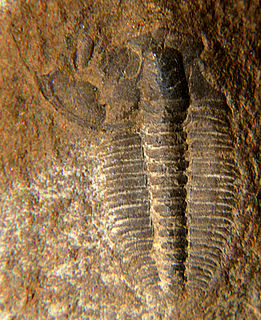In Greek mythology, Olenus was the name of several individuals:

Rudolf Kaufmann, son of the physicist Walter Kaufmann, was a palaeontologist and geologist, and is best remembered for his work on allopatric speciation and punctuated equilibrium in the trilobite genus Olenus in the Upper Cambrian of Sweden and on the island of Bornholm. He was a brother-in-law of Curt Teichert, the well-known German-American palaeontologist and geologist. Studying the Upper Cambrian alum shales in Sweden, Kaufmann found that the trilobite genus Olenus occurred in an unbroken sequence of sediments covering a considerable period of geological time. He was thereby in a position to track the phylogenetic evolution of Olenus, that is, the rise and fall of species within the genus and the changes in their morphology. He coined the idea of Artabwandlung, which is the tendency of clade elements in the same environment to show the same morphological trends.

Olenus is a genus of Upper Cambrian ptychopariid trilobite.

Olenecamptus is a genus of longhorn beetles of the subfamily Lamiinae.
Olenecamptus siamensis is a species of beetle in the family Cerambycidae. It was described by Stephan von Breuning in 1936. It is known from China, Sumatra, Myanmar, Vietnam, Thailand, and Taiwan. It contains the varietas Olenecamptus siamensis var. reductus.
Olenecamptus indicus is a species of beetle in the family Cerambycidae. The species was first described by Stephan von Breuning in 1936, originally under the genus Cylindrepomus. They have since been reclassified as part of the Olenecamptus genus.
Olenecamptus pseudostrigosus is a species of beetle in the family Cerambycidae. It was described by Stephan von Breuning in 1938.
Olenecamptus formosanus is a species of beetle in the family Cerambycidae. It was described by Maurice Pic in 1914. It contains the varietas Olenecamptus formosanus var. decemmaculatus. It occurs in East Asia.
Olenecamptus optatus is a species of beetle in the family Cerambycidae. It was described by Pascoe in 1866. It is known from Thailand, Singapore, Malaysia, Sumatra, Vietnam.
Olenecamptus strigosus is a species of beetle in the family Cerambycidae. It was described by Pascoe in 1866. It is known from Moluccas, Indonesia, and Papua New Guinea.
Olenecamptus vittaticollis is a species of beetle in the family Cerambycidae. It was described by Heller in 1923, originally as a subspecies of Olenecamptus optatus. It is known from the Philippines. It contains the varietas Olenecamptus vittaticollis var. divisus.
Olenecamptus albidus is a species of beetle in the family Cerambycidae. It was described by Jordan in 1894.

Olenecamptus bilobus is a species of beetle in the family Cerambycidae. It was described by Johan Christian Fabricius in 1801, originally under the genus Saperda. It is known from Myanmar, India, Papua New Guinea, Indonesia, Laos, Seychelles, Madagascar, Australia, Sri Lanka, Japan, Sumatra, Java, Philippines and Taiwan.
Olenecamptus cretaceus is a species of beetle in the family Cerambycidae. It was described by Bates in 1873.
Olenecamptus indianus is a species of beetle in the family Cerambycidae. It was described by Thomson in 1857, originally under the genus Authades. It is known from Myanmar, Malaysia, Vietnam, Thailand, and India. It contains the varietas Olenecamptus indianus var. salweeni.
Olenecamptus tessellatus is a species of beetle in the family Cerambycidae. It was described by William Lucas Distant in 1898.

Olenus or Olenum was a polis (city-state) in ancient Achaea, Greece. It was an original member of the Achaean League, one of the 12 Achaean cities, situated on the coast, and on the left bank of the river Peirus, 40 stadia from Dyme, and 80 stadia from Patrae. On the revival of the Achaean League in 280 BCE, it appears that Olenus was still in existence, as Strabo says that it did not join the league; but the inhabitants subsequently abandoned the town, and retired to the neighbouring villages of Peirae (Πειραί), and Euryteiae (Εὐρυτειαί), and to Dyme. In the time of Polybius, however, Olenus was no longer inhabited; and in the time of Pausanias it was in ruins, and its territory belonged to Dyme.
Olenus is one of a number of figures in Greek mythology.
Peirae or Peirai was a village of ancient Achaea in the neighbourhood of Olenus, and one of the places to which the inhabitants of Olenus fled upon leaving their city.
Euryteiae or Euryteiai was a village of ancient Achaea in the neighbourhood of Olenus, and one of the places to which the inhabitants of Olenus fled upon leaving their city.





